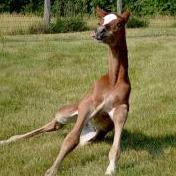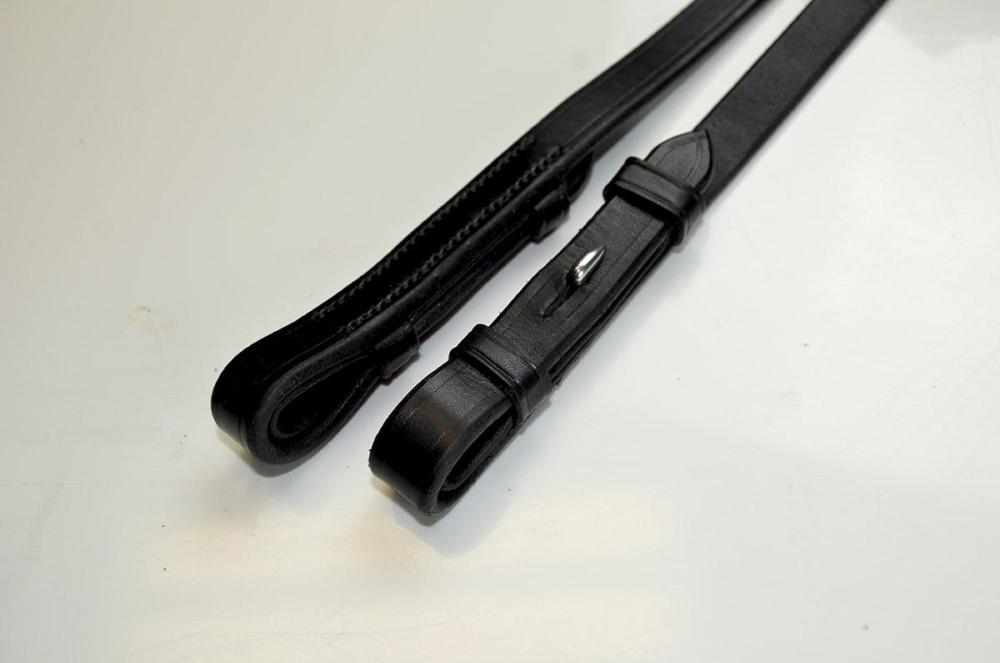-
Posts
1,287 -
Joined
-
Last visited
Content Type
Profiles
Forums
Events
Blogs
Gallery
Everything posted by TomE
-
A classic. Very nice work. Do you trim the edge of the round handles after sewing? How do you get that close to the edge? Now I see that it is hand sewn. Lots of work!
-
Very pretty. The background nicely sets off the artwork.
-
I think using a stitch groover is more about aesthetics than preventing wear. I would be interested in people's experiences with stitches breaking because of abrasion. I've only seen it happen on the toes of my work boots when they are well worn. For horse tack it is usually the leather that breaks, not the stitches. As a corollary, I don't see that machine stitching unravels and is somehow inferior to hand sewing, but I digress. I don't use a stitch groover for sewing because I'd rather not remove the grain, the strongest part of the leather. I do use a heated crease fairly often, but mainly for decorating straps that aren't sewn except at the ends for attaching hardware. To answer your question, if you like the look of stitches in a groove I'd keep doing it. I think the quality of tannage and weight of the leather will determine the durability.
-

How much to charge for your leather goods?
TomE replied to GrampaJoel's topic in Leatherwork Conversation
I am enjoying the collective wisdom and experiences of the commenters (commentators?) in this thread. Lots of good insights. Thanks for sharing your thoughts. -

Creasing belts - Wet creasing VS Heat creasing?
TomE replied to LzCraft's topic in How Do I Do That?
Yes, a heated creasing iron will quickly cool on cased leather, not to mention scorching the leather on initial contact. The crease should be warm enough to move smoothly but not so hot that it burns the grain. The heat serves to burnish the crease line. Start with light pressure to establish your line then press more firmly to finish. I usually go over crease lines twice during a project, first after burnishing the edge and again before applying conditioner at the end of the project. When I am blocking loops I re-crease the damp leather without heat. -
My day job mucking stalls and making/taking care of foals keeps getting in the way of starting a leathercraft business from my hobby. However, the dream lives on. I use scrap to practice construction and finishing techniques, and in the process figure out what I'm good at and what I enjoy. I bought a larger splitter with plans to make small bags and cases from bridle side leftovers.
-
I think it’s been 40 yrs since I saw a CB radio. :)
-
Probably would include a fixed loop/keeper to secure the free end of the strap so it doesn't lift off the Sam Browne stud. A stud hook is a related device that attaches the bit to a bridle or reins. It's a little more complicated to install. Typically sandwich the base of the stud hook between 2 layers of leather and include fixed loops on either side of the hook. Definitely not quick release.
-
See my comment above.
-
This thread has some useful information on refinishing upholstery. @Wizcrafts mentioned this refinishing system https://www.wood-n-stuff.com/ that I'm thinking about trying on a faded red leather chair.
-
That makes sense. Couldn't see the difference between 1.02mm and 1.09mm diameter. I'll need to make a smaller awl for that #4 needle and #92 thread, and maybe pick up a new set of eyeglasses.
-
@Hazza I was curious and checked what I had on hand. The John James needles on the left are sizes 1/0, 003, and 004. The 004 is smaller, and the other 2 are the same diameter and slightly different lengths. On the right are Osborne needles in 18, 19, and 20 gauge. I use the 19 gauge needle with #207 bonded nylon thread, and the 18 gauge needle for #277 thread. I've bent them using pliers when overstitching in thick leather, but I've never had one break. Very happy with the Osborne needles.
-
That is one gnarly bag! Guitar slinger shoulder strap is the topper. Put a smile on my face. Hats off to your creative talents.
-
Thanks for the summary. Good info that will help me navigate future (inevitable) challenges.
-
You probably saw @bruce johnson's description of push beaders on his website. He mentioned potential problems with beaders that are sharp and cut the grain, in comparison to the usual style that is blunt and burnishes the lines without cutting the grain - like a crease. I haven't used a beader but for burnishing a crease line I like the traditional handle on a curved shank. It is comfortable while pushing firmly to burnish, and the tool is visible in front of your hand to maintain the desired line. Barry King has this style of push beader in stock. https://www.oaleathersupply.com/collections/barry-king-tools/products/barry-king-push-beader
-
If you need to go deeper with the French edger you can run a stitch groover along the sides of the channel and repeat with the French edger. The grooves will allow the feet of the French edger to go deeper. Of course, the French edger should be very sharp. I've not sewn a miter joint but it looks rather inflexible. If you need a flexible joint it is probably the wrong method.
-
In Stohlman's "The Art of Hand Sewing Leather" he describes the process of sewing a miter joint to create a tidy looking square edge. A French edger will cut a channel for your magnets. Works best using leather of a firm temper. I use the #2 Ron's French edger to seat stud hooks in the platform of bridle cheek pieces and reins. https://ronstools.com/straight-french-edgers/
-
I guess it depends on the look you’re going for. I like a simple crease line made with a heated crease. I typically crease after burnishing the edge and again after assembly/sewing. I am reluctant to cut the grain but understand it’s necessary for a more pronounced border.
-
I would add moisture to the leather with a light coat of neatsfoot oil on the grain side. Leave it overnight then buff thoroughly with a soft cloth. Rub the stitching with a bone folder to smooth the wrinkles, and lighten up on your thread tension (pulling up stitches) next time you sew to avoid the wavey edge. I haven't used Fiebings Leather Balm but think it will allow the oil to penetrate. As always, oiling might darken the leather - give it several days to even out before judging the final color.
-

How about this Embroidered Jacket?
TomE replied to ElliotKennedy's topic in Clothing, Jackets, Vests and Chaps
That is a show stopper! Looks like Buster Scruggs' Sunday best except that it's off the rack https://urbanjacket.com/products/pawn-stars-zz-top-jacket.- 12 replies
-
- leather jackets
- jackets
-
(and 1 more)
Tagged with:
-
Thanks, @Rwest. That is a fun and informative film.
-
Handsome and well constructed. Good job!
-
Thanks, @chuck123wapati. I’m on the steep end of the learning curve and enjoy all the information I am able to soak up here. Thank you, Bruce. I will give it a read. Fun to learn this stuff.
- 29 replies
-
Those are beautiful knives, the design looks like a great size/shape. I recently bought 2 used Dozier knives made out of D-2 steel. Can you educate me about the pros and cons of D-2 versus the AEB-L steel you used?
- 29 replies
-

Quality of Blanchard Pricking Irons and Beginner Purchase List
TomE replied to frankly's topic in Leather Tools
Vergez Blanchard is not the Blanchard of old. I purchased one of their pricking irons that looked like a high school shop project - very rough and unfinished. After hours of carefully smoothing and polishing the tines, it is useable. Similarly, I ended up reshaping their screw crease until I was happy with it but not as happy with it as with older Gomph and Osborne creases. Finally, I played around for 6 months with their plough gauge knife, changing the taper and adding a small bevel to the backside to prevent the plough gauge from pinching the strap so hard that it would hang up. Vergez Blanchard did not respond to my emails asking about the plough gauge knife. All of these tools were expensive and I am now satisfied with how they perform but it required some work. I do a lot of hand sewing of 9-20 oz leather - bridles, reins, halters - and I commend you for your plans to learn how to use a sewing awl. Using a correctly sized, sharp awl produces smaller holes that close around your thread and look neater IMO. An awl will produce a hole in thick leather that is about the same size on the front and the back. Using a sewing awl is also more versatile than pre-punching holes in dealing with unusual shapes, tight spaces, multiple layers, angling holes when stitching under a loop, etc. I greatly prefer the Rocky Mountain European pricking irons over the Blanchard iron I purchased. I mainly use the 2.7 mm spacing (9 SPI) and I rarely use the 2 prong iron - I just tip the wider iron on edge and lighten up on my maul when turning a corner. You could consider a pricking iron for your common hole spacing and an inexpensive set of overstitch wheels to cover other hole spacings. My awls are all Osborne awls. I bought one expensive awl that was a piece of junk. No reason to spend a lot on a fancy awl haft. Find one that fits your hand and focus on learning to sharpen the awl. Al Stohlman's book and Nigel Armitage's videos will show the method. As you sharpen an awl repeatedly it gets smaller and more suited for fine stitching. So having several inexpensive, sharp awls that are in various stages of wear will give you a range of sizes. I would buy a quality stitching horse or clam. I modified a Weaver stitching horse with notched out aluminum plates, based on a plywood version shown in a Stohlman book, and this is handy for working with straps and buckles.




.thumb.jpg.2c51715cc2d68401608c542e3748f4ab.jpg)
